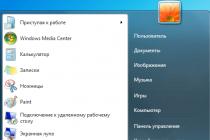Recall last year, Apple showed the iPhone 5. The first iPhone with a larger display diagonal up to 4″, and at the same time, it was a return of the classic iPhone because of the solid aluminum body. Everything seems to be fine, what questions could there be for him? And they were, and they appeared immediately after the unboxing. First of all, I was surprised by the quality of processing of the new aluminum case, all the models that came across to me within a few weeks from the start of sales seemed to be used. There were scratches and chips on the ends of the white model, and the black one lost its presentable appearance after a few weeks of use.

After some time, the technological process, due to which the body of the white model suffered, was corrected and the chips disappeared. The painting of the black model was also improved, but, nevertheless, it was not possible to bring it to the ideal state - over time, the paint peeled off the ends. For comparison, as I wrote in, after 9 months it looks worse than the iPhone 4s that I used two years ago and now he lives with a friend. It shouldn't be like this, and Apple obviously understands this.
The case is not the only problem of the “five”. In I talked about a bad speaker, about a worsened camera, about a marriage with a lock key, about dust on the camera matrix, which, as it turned out, does not get there for any of me. What we have? Exactly the same thing that they had in the case of the iPhone 4 - completely new model, but with a whole bunch of so-called children's sores. We recall the iPhone 4s - it fixed all the diseases of the “four” and it was my first personal iPhone. Having used the iPhone 5 for a long time, I continued to consider the 4s the best of all iPhones. And my opinion has changed only now - when I met the new iPhone 5s.

Now I know for sure that every iPhone with an additional “s” is not an intermediate model, but a polished and completely refined previous one. The new product fixed almost everything that I could find fault with. I'll start talking about my impressions of using 5s.
The design of the model remained the same, only the flash has changed, now it is double, and the Home button. But the main thing that has changed is the color of the black model. Apparently, the paint cannot but peel off the edges, therefore, they decided to abandon it. Now there is no completely black model, instead of it - Space Gray. The aluminum case itself, namely, the side edges and the back wall, are no longer painted on top, the part is just gray. The front side and inserts at the back remained black. Now came out, so-so, “wet asphalt” – my favorite color in cars. For the first time, I will buy myself not a white phone, but a gray one, because it looks unrealistically cool.
![]()

The white model remained unchanged and, perhaps, this also influenced my choice, the white one got fed up over the year. Another color has been added - gold, whatever it's called. Despite the fact that it was dismantled faster than anyone else, I am not at all enthusiastic about it. I think this coloring was brought in in smaller quantities, so it was dismantled faster.
touch ID
Now let's move on to visual differences, the main thing is the Home key. This is the feature that distinguishes the iPhone 5s both in hardware and software. Back in the 4th or 5th beta of iOS 7, support for a fingerprint scanner was discovered, then it became clear what the emphasis would be on. The scanner is built into the Home key, which is why there is no pattern on it now. Also, the button has become flat and is now made of sapphire crystal so that it does not get scratched.

After the presentation, I was wondering how adequately this scanner would work, and now, having used the smartphone for the weekend, I give myself the answer - very adequately. You can disable the scanner in the settings, but I did not have such a desire. The fact is that I clearly understand why I need such security. I have several apps on my iPhone that I have password-protected because I don't want even my friends to see, for example, my budget. I used to use Coin Keeper without a password, recently I decided to install it and immediately noticed that even entering 4 digits significantly burdens the process. Now I will unblock both Evernote and Coin Keeper, because no one will unlock my smartphone. Yes, previously it was also possible to set an unlock password, but, as I said, this makes it too difficult to constantly use the smartphone, and I unlock it very often.
Of course, there is no need for someone to lock their smartphone, but you must admit that entering a password when installing each new application has bothered everyone. Especially when Apple introduced new password requirements. Now you can install applications using your fingerprint. This is cool, no one will buy anything for you, but you don’t need to worry about entering a complex password either. Now I'm really looking forward to a similar scanner coming to the iPad and MacBook.

You can set up a fingerprint the first time you turn on your smartphone, later this is done in the Main menu - Scanner and fingerprint. Here you need to enter a password, after which you can add / remove a fingerprint. There are five fingerprint slots in total, and multiple fingers can be added to one slot. I, for example, added the entire right hand to one slot and all fingers are recognized. Moreover, the work of the scanner is such that it recognizes the touch in any position, even if you take the smartphone upside down. In one slot, by the way, I kept my nose. Working. I think other parts of the body will work too.


We recently took an unboxing of the iPhone 5s and this video shows you how Touch ID works in detail:
Camera
But for me, the main innovation was by no means a sensor, I was most looking forward to a new camera. And, exactly the way she became. I have never been a fan of a large number of MPs, because their quantity does not affect the quality. For detailing - yes, but only with an increase in quality, and therefore with an increase in the sensor. In this case, the camera has been improved, and quite seriously. And, most importantly, not in software, but physically. The sensor size was increased by 15%, while leaving 8 MP, and the aperture ratio was increased from 2.4 to 2.2. This means that each pixel has become larger and is able to receive more light, and even aperture 2.2.

In practice, this means better shooting in low light, again, not stretched by software, more “adult” depth of field, and this is clearly visible when compared with the iPhone 5 in similar shots, and, attention, the absence of lilac highlights when shooting with side light . This unrealistically interfered a lot when I wanted to get glare, but even under normal conditions, such highlights often appeared.
Thanks to a more powerful A7 processor and an ISP chip responsible for processing photos, the camera has become very fast. By pressing the shutter button, the camera starts to literally scribble pictures. After that, you can choose the best one or keep them all.
Examples of photos taken with the main camera. Left - iPhone 5s, right - iPhone 5
In addition, there was a double flash. The bottom LED is yellow and is meant to make skin tones look more natural when you take photos with flash. But that's not all, a very nice innovation was shooting video at 120 fps at 720p. Moreover, honest 120 fps, the recording frequency does not drop even in a dark room. After recording a video in this format, right while watching, you can choose the moment where it will slow down. The effect is simply unreal, now I understand that the video with which the skater was shown during the presentation was indeed filmed on the iPhone 5s. Again, I'm glad that this is not a function for the sake of a function, this is what will be used. To record at 120 fps, you need to go to the leftmost camera window.
SloMo video example
The front camera is also better, with a backlight sensor, so front camera photos in low light will also be better. But here the difference is much less noticeable than in the case of the main camera.

Examples of photos taken with the front camera. Left - iPhone 5s, right - iPhone 5
I was also waiting for the increased battery capacity. In the novelty, the battery capacity is 1570 mAh, which is 170 more than in its predecessor. On time battery life it affected, but you have to understand, I'm comparing it with the iPhone 5, which is almost a year old. It would be more correct to compare the autonomy of the two just printed models, but I do not have such an opportunity.

And the last thing I was waiting for was the return of the vibrating alert from the iPhone 4s. That did not happen.
Performance
Of course, the novelty has new processor- 64-bit A7, new graphics and new RAM. At the same time, the number of cores remained the same - two, as well as the volume random access memory– 1 GB. In the synthetic test GeekBench 3, the increase in performance is twofold.


We did a little performance comparison of the iPhone 5s and iPhone 5 and made a video about it:
As you can see, the difference is far from what we saw a year ago, when the iPhone 4s lost a lot to the “five” in launching games, as well as in multitasking. Today, performance in the iPhone 5s is not something worth thinking about changing for.
At the moment only standard applications and the game Infinity Blade 3 support 64-bit, but Apple promises a “painless” transition to the new architecture for other developers as well. How this will affect users is not yet clear to me.

One thing is obvious - the difference will be visible, only a little later. Then we will understand the need for another node in new iPhone- coprocessor M7, which combined a gyroscope, accelerometer and electronic compass. It should help save battery power when navigating, as well as in applications that track the position of the smartphone. I really hope that substitutes for any health bracelets will begin to appear.

As I said, this is not a review in the form that you are used to seeing on a cedar, and I will not dwell on what you might have read in . The layout of the elements of the two smartphones has not changed, the display has also remained the same. Speaking of the latter, I cannot say that it is outdated. If we ignore the race for ppi, the iPhone 5s has a very high-quality 4″ display.

Specifications iPhone 5s
- Dimensions: 123.8 x 58.6 x 7.6 mm.
- Weight: 112 g.
- Operating system: iOS 7.
- Processor: dual-core, Apple A7, 1.7 GHz
- Display: IPS, 4.0″, 1136 × 640 pixels, 326 ppi
- Memory: 16, 32, 64 GB.
- RAM: 1 GB.
- Camera: main - 8 MP, video recording at 1080p/30 fps and 720p/120 fps, front - 1.3 MP, video recording at 720p/30 fps.
- Wireless technologies: Wi-Fi 802.11 a/b/g/n, Bluetooth 4.0.
- Interface connectors: 3.5 mm headphone jack, Lightning.
- Battery: Li-Pol battery 1570 mAh.

Summing up a small summary of all of the above, I note: Apple has exceeded my expectations. Although I'm not 100% happy with the updated iOS design, the smartphone itself turned out great. There are no controversial features in it, about which one would think that they will disappear in a couple of generations as unnecessary. I think that both the scanner and the M7 will be further developed by Apple, moreover, similar solutions will soon be seen in devices from other manufacturers.
Personally, I liked the novelty, first of all, new camera. I won't tell you why this is so important to me, if you follow the cedar, you should know for yourself. Also very pleased with the scanner and the new color - gray. This year I don’t hesitate a bit whether I need to upgrade, definitely yes.
Despite the fact that each Apple new smartphone presented as ideal, even the biggest fans of the "apple" brand understand that they exist in model range iPhone and strong, and weak devices. In this article, we have to answer the question, what is the flagship phone of 2013 year iPhone 5S.
Briefly about innovations
At first glance, the iPhone 5S is not much different from its predecessor, the iPhone 5. However, in fact, Apple has done a good job both on the external and on the internal changes to this model. What's new in S-ke? There are many modifications and here are only the largest of them:
- improved manufacturing process of the body
- new processor
- improved camera
- touch ID
- iOS 7
As you can see, there is a lot to talk about. V this review Let's take a closer look at these and less significant changes in Apple iPhone 5S, as well as analyze its pros and cons. The description will start, of course, with the design.
Appearance
So, as we mentioned above, externally 5S, at first glance, looks exactly like its predecessor - iPhone 5. Slim aluminum body, silver side edging, original back panel: top and bottom glossy stripes in a bright color - black or white, coated tempered glass, and between them - a matte "center" of a discreet shade - gray or silver. And, of course, a shiny “apple” stands out on a matte surface.
But if you look closely at the rear panel, you can see that the flash looks a little different, and looking more closely at the front, you notice a much more serious difference. The Home button looks different - the one located under the display. Throughout the history of the iPhone, this key looked the same, and now in the 5S it lost the square outline depicted in its center, but received a nice border around the perimeter, and also ... a fingerprint scanner was built into it. However, we will talk about this innovation in a separate section.
![]()
And now about another important change in appearance. For S-ki, Apple came up with a model in a new color - white and gold. Finally, "fun" changes in the traditionally strict colors of the iPhone! By the way, the black-gray and white-silver models have also undergone some changes - the silver one has become a little, and the gray one is noticeably lighter.
And, finally, about external changes that you can't notice, no matter how much you look at it (yes, such a paradox) - an improved technological process for applying paint to a matte body and side edging. The fact is that from the 5th the application literally fell off. This was perhaps the worst "bug" of the iPhone five, and all users suffered from it, even those who carefully packed the device in a protective case. It seemed that even if the five would just stand beautifully on the shelf, the paint from it, too, would certainly crumble slowly.

Luckily, Apple didn't pretend the problem didn't exist and quickly took appropriate action to fix it, and voila, the paint doesn't peel off the iPhone 5S. Moreover, the “apple” giant also worked with the buttons, they are pressed more tightly and clearly, and they sit more securely in the case. Not to say, of course, that in the top five everything was kept on parole, but the body of its follower is made much better.
Some users even say that the iPhone 5S is heavier and feels more solid in the hand. If it seemed so to you, then to the question - how much does an iPhone 5S weigh, we have an amazing answer for you - 112 grams, like a five.
iPhone 5S and dimensions in all three "dimensions" are the same as its predecessor: width - 5.86 centimeters, length - 12.38 cm, thickness - 0.76 cm.
The location, type of sockets and connectors for the S-ki is the same as for the five (the exception is the Home button, but we have already said everything about it). How many speakers are in the iPhone 5 S? Again, just like the fifth one, there are two of them, one transmits voice and is located above the display, the second is for speakerphone, listening to music, etc. - on the lower right side.
Display
What's different about the iPhone 5S display? It has not changed much - a diagonal of 4 inches, a resolution of 1136x640 pixels, a pixel density of 326 ppi. However, why change something if the clarity is excellent, the viewing angles are as wide as possible, the margin of brightness is sufficient.
Color reproduction deserves a separate compliment - all shades are bright, but natural, unlike, for example, the display of one of the main competitors 5S - Samsung smartphone Galaxy S5, which "sins" with excessive saturation.

The only drawback of the screen in the iPhone 5S is the size, after all, 4 inches is no longer enough to comfortably solve all the tasks of a modern user, reading books and watching movies, for example, is completely inconvenient. On the other hand, it's a matter of taste, if you like to read books from paper, and watch movies on a huge plasma, no "shovel" will save you.
Hardware and software
The iPhone 5S was the first phone to feature a 64-bit processor, but the move was met with mixed reactions. Maybe now mobile applications began to adapt to this architecture, but at the time of release, such a solution was more of a reserve for the future than an improvement needed by users here and now.
But what was actually expected from Apple, namely an increase in the number of cores - from 2 to 4, did not happen. The 64-bit A7 processor runs on 2 cores with a maximum clock speed of 1300 MHz. The size of the RAM has also not changed - 1 GB.
However, here, as in the case of the display, I would like to ask - why do we need 4 cores and more RAM, if this "apple" device demonstrates excellent specifications and with less modest parameters? The speed of the iPhone 5S is fast, everything runs very smoothly and without freezes. Some competing flagships are not able to perform such precise work even on 4 cores. And all because competitors operate on Google Android and do not have the ability to optimize the platform for hardware, but Apple is working on its “native” iOS from year to year, and the results are making themselves felt.

However, in the case of the iPhone 5S, everything did not go as smoothly as usual. The S-ka was the first smartphone to come preloaded with iOS 7. iOS 7 is, then and still is, the biggest platform update ever. And it's not just about new features - what is the long-awaited "curtain" of quick access to the most frequently used functions, but also about a complete visual revolution. Of course, such drastic changes took time to take root, so some barely noticeable lags in the first iOS versions 7 took place, but, one way or another, they were the most inconspicuous on the S-ke, both fours and the iPhone 5 could be updated to this version.
How much more powerful is the new A7 processor than the A6 that was bundled with the top five? According to Apple - twice, in fact, the same is confirmed by benchmarks, but, as for the obvious difference for the average user, it will be noticeable only on really "heavy" applications, like iMovie and 3D games. Well, as for the speed of performing light and medium tasks, the difference between the work of A6 and A7 is measured literally in fractions of a second.
By the way, the iPhone 5S is also equipped with an M7 co-processor, which is mainly responsible for motion sensors and allows the main chipset to rest on tasks such as counting steps. This "rest" leads to more economical battery consumption, which means that offline time work is increasing.
As for the ROM, S-ka, like the iPhone 5, is available in three variations - 16, 32 and 64 GB.
touch ID
Special attention should be paid to the new Home button, which is now Touch ID or, in Russian, a fingerprint scanner. iPhone 5S was the first i-smartphone in which you do not need to enter a password to unlock, you just need to touch home buttons.

I must say, at the time of the release of S-ki, other flagships were already working with similar solutions, however, time has shown that Apple is still the only company that has made a really cool fingerprint sensor. Everything is configured according to a very simple instruction, the original print is remembered quickly, the operation is clear, instant and almost error-free.
By the way, you can use Touch ID not only to unlock your smartphone, but also to purchase applications in App Store, that is, in fact, the scanner replaces two passwords - unlock and Apple ID. In general, very convenient.
cameras
The sensor in the iPhone 5S camera remained the same - 8 megapixels as in the fifth iPhone, but the pixel size was increased and the aperture value was reduced, which made it possible to obtain better shots in low light conditions.
In addition, Apple has invented a new flash true tone, which also works to improve the quality of night shots.
Well, improvements on the "little things" - improved detail and viewing angle, increased clarity.
In general, the megapixels are the same, but the result is completely different. You will definitely notice the difference between the shots on the five and on the 5S, especially if the shot was taken not in daylight, but in not very good lighting conditions.
New features have appeared in the video mode, the coolest of them is the slow motion function at 120 frames per second. Of course, this is unlikely to be useful to ordinary users, but the thing is definitely funny, after all, practical meaning is not always needed, sometimes you can indulge.

Concerning front camera, there is nothing special to say here, it shoots very well, but not noticeably better than five.
autonomy
The battery capacity of the S-ki has increased in comparison with its predecessor by only 120 mAh and is 1560 mAh. However, as you remember, the 5S battery has to "pull" twice as much powerful processor. Nevertheless, it seems like a not much enlarged battery copes. Smartphone Apple iPhone 5S as well as the five will last the day in an active-moderate mode. Quite good autonomy for a modern flagship.
To take or not to take?
So, the iPhone 5S review has come to an end. At the beginning of the article, we talked about the fact that Apple has both weak and strong models. Who is the hero of this post?
I think, by the general “warm” tone of the review, you understood that we put S-ku in the second category, and this is justified. There are a lot of changes and the iPhone 5S shows excellent performance.
What is good about this device, and how does it differ from its predecessor? First, Apple fixed the process errors, so if the 5 wears out very quickly, the iPhone 5S will delight you with an impeccable look for a long time. Secondly, a new processor has appeared, which, yes, is not 4-core and the RAM is very modest by today's standards, but these resources are enough for fast, lag-free work. Thirdly, a camera that opens up new possibilities in low light conditions. And finally, Touch ID. And these are not all positive changes, but only the most important ones.
If you want to find significant disadvantages of the iPhone 5S, then it will probably not be easy for you. The only thing you can find fault with is a small diagonal, but, as we have already said, this is a very subjective drawback.
So is it worth buying an iPhone 5S? If you have any other low-end iPhone, you will definitely feel the difference if you buy an S (even compared to a 5). However, there is one thing. Today there is another very interesting iPhone model on the market, it is called SE - Special Edition.

This device was released after the 6S, especially for those who are nostalgic for a very successful fifth series. Externally, the SE is almost one in one 5S, but the filling in it is almost as powerful as that of the 6S. That is, the SE "makes" even the six, but at the same time it costs less.
The average price of the iPhone SE is 26,000 rubles, the iPhone 6 is 36,000 rubles. However, you can get the iPhone 5S for 18,000 rubles (all prices are for the 16 GB version). In general, everything depends on the size of the wallet, the 5S is, of course, a great smartphone, but the SE is several orders of magnitude more powerful, so if finances allow, you should take a special version. Do not allow? Take the iPhone 5S and be sure you are buying a really cool and powerful device.
iPhone 5s is the most popular iPhone model in Russia and here are its parameters.
Body colors
- space grey, gold and silver.
Memory capacity
- 16 GB (new and refurbished).
- 32 GB (new and refurbished).
- 64 GB (refurbished only).
Weight and Dimensions

- Length: 123.8 mm.
- Width: 58.6 mm.
- Thickness: 7.6mm.
- Weight: 112 g.
CPU
- A7 processor with 64-bit architecture.
- M7 coprocessor.
- Mobile and Wireless:
- Model A1533 (GSM)*: UMTS/HSPA+/DC-HSDPA (850, 900, 1700/2100, 1900, 2100 MHz); GSM/EDGE (850, 900, 1800, 1900 MHz); LTE (bands 1, 2, 3, 4, 5, 8, 13, 17, 19, 20, 25).
- Model A1533 (CDMA)*: CDMA EV-DO Rev. A and Rev. B (800, 1700/2100, 1900, 2100 MHz); UMTS/HSPA+/DC-HSDPA (850, 900, 1700/2100, 1900, 2100 MHz); GSM/EDGE (850, 900, 1800, 1900 MHz); LTE (bands 1, 2, 3, 4, 5, 8, 13, 17, 19, 20, 25).
- Model A1453*: CDMA EV-DO Rev. A and Rev B. (800, 1700/2100, 1900, 2100 MHz); UMTS/HSPA+/DC-HSDPA (850, 900, 1700/2100, 1900, 2100 MHz); GSM/EDGE (850, 900, 1800, 1900 MHz); LTE (bands 1, 2, 3, 4, 5, 8, 13, 17, 18, 19, 20, 25, 26).
- Model A1457*: UMTS/HSPA+/DC-HSDPA (850, 900, 1900, 2100 MHz); GSM/EDGE (850, 900, 1800, 1900 MHz); LTE (bands 1, 2, 3, 5, 7, 8, 20).
- Model A1530*: UMTS/HSPA+/DC-HSDPA (850, 900, 1900, 2100 MHz); GSM/EDGE (850, 900, 1800, 1900 MHz); FDD-LTE (bands 1, 2, 3, 5, 7, 8, 20); TD-LTE (bands 38, 39, 40).
- Wi-Fi 802.11a/b/g/n (802.11n on 2.4GHz and 5GHz).
- Wireless bluetooth technology 4.0.
Geolocation
- Assisted GPS and GLONASS.
- Digital compass.
- WiFi.
- Mobile network.
touch ID
- Fingerprint identification sensor built into the home button.
Display:
- Retina display.
- 4" widescreen Multi-Touch display.
- Resolution 1136 x 640 pixels (326 ppi).
- Contrast ratio 800:1 (typical).
- Brightness up to 500 cd/m2 (standard).
- Oleophobic coating that prevents fingerprints on the front panel.
- Support to display multiple languages and character sets at the same time.
iSight Camera
- 8 megapixels, 1.5µ pixel size.
- Aperture ƒ/2.2.
- The lens is protected by sapphire crystal.
- Flash True Tone.
- Five lens lens.
- Hybrid IR filter.
- Autofocus.
- Touch focus.
- Face recognition.
- Panoramic shooting.
- Burst shooting.
- Attaching photos to the shooting location.
Video recording
- HD video recording in 1080p.
- 30 fps.
- Flash True Tone.
- Shooting slow motion video.
- Advanced video stabilization feature.
- Ability to take photos while recording video.
- Face recognition.
- Triple zoom.
- Linking the video to the shooting location.
face time camera
- Photos with a resolution of 1.2 megapixels (1280×960).
- HD video recording in 720p.
- Light sensor on the back.
Controls

Video calling
- face time
- Video calls over LTE, DC-HSDPA, HSPA+, 3G and 2G networks.
- Video calls with HVGA resolution (480×368) over WiFi networks.
Audio communication
- facetime.
- iPhone 5s to any FaceTime-enabled device over Wi-Fi or network mobile communications.
Sound
- Supported audio formats: AAC (8 to 320 kbps), protected AAC (for files from iTunes Store), HE‑AAC, MP3 (8 to 320 kbps), MP3 VBR, Audible (formats 2, 3, 4, Audible Enhanced Audio, AAX and AAX+), Apple Lossless, AIFF and WAV.
- User configurable maximum volume.
Apple Pay
- Support payment system Apple Pay no. Apple Pay is only available when paired with the iPhone 5s Apple Watch.
TV and video
- AirPlay video mirroring and video output on Apple TV (2nd and 3rd generation).
- Video mirroring and video output support: up to 1080p with Lightning Digital AV Adapter or Lightning to VGA Adapter (adapters sold separately).
- Supported video formats: H.264 video up to 1080p, 60fps, High Profile Level 4.2 with AAC-LC audio up to 160kbps, 48kHz, stereo audio in .m4v, .mp4, and .mov formats; MPEG-4 video up to 2.5 Mbps, 640 x 480 pixels, 30 fps, Simple Profile with AAC-LC audio up to 160 kbps per channel, 48 kHz, stereo audio in .m4v, .mp4 and. mov; Motion JPEG (M-JPEG) up to 35 Mbps, 1280 x 720 pixels, 30 fps, ulaw audio, PCM stereo audio in .avi format.
Power and battery
- Built-in lithium-ion battery.
- Charging via USB from a computer or power adapter.
- Talk time: up to 10 hours on 3G network.
- Standby: up to 250 hours.
- When using the Internet: up to 8 hours in a 3G network; up to 10 o'clock in LTE networks, up to 10 hours on Wi-Fi.
- Video playback: up to 10 hours.
- In audio playback mode: up to 40 hours.
Sensors
- Three axis gyroscope.
- accelerometer.
- distance sensor.
- Ambient light sensor.
Embedded Applications

Free Apps

Headphones
- Headphones Apple EarPods with remote control remote control and microphone.
- Case for storage and transportation.
SIM card
- Nano-SIM (iPhone 5c does not support existing Micro-SIM cards).
- iPhone 5s does not support existing Micro-SIM cards.
connector
- Lightning.
Mail attachment support
- Support for viewing documents of the following types:
- .jpg, .tiff, .gif (images); .doc and .docx ( Microsoft Word); .htm and .html (web pages); .key(Keynote); .numbers(numbers); .pages(Pages); .pdf (Viewer and Adobe Acrobat); .ppt and .pptx (Microsoft PowerPoint); .txt (text); .rtf (formatted text); .vcf (contact information); .xls and .xlsx ( Microsoft Excel); .zip .ics.
System requirements
- Apple ID (required for some features).
- Internet access.
Syncing with iTunes on Mac or PC requires
- Mac: OS X 10.6.8 or later.
- PC: Windows 8; Windows 7; Windows Vista or Windows XP Home or Professional ( service pack 3 or later).
- iTunes 12 or later.
Requirements for the environment of use
- Operating temperature: 0 to 35 °C.
- Storage temperature: -20 to 45°C.
- Relative Humidity: 5 to 95% (non-condensing).
- Maximum operating altitude: 3000 m.
Languages
Supported languages
English (UK), English (US), Arabic, Hungarian, Vietnamese, Dutch, Greek, Danish, Hebrew, Indonesian, Spanish, Italian, Catalan, Chinese (Traditional), Chinese (Simplified), Korean, Malay, German, Norwegian, Polish, Portuguese, Portuguese (Brazil), Romanian, Russian, Slovak, Thai, Turkish, Ukrainian, Finnish, French, Croatian, Czech, Swedish, Japanese.
Supported keyboard layouts for languages
English (Australia), English (UK), English (Canada), English (USA), Arabic, Bulgarian, Hungarian, Vietnamese, Hawaiian, Dutch, Greek, Danish, Hebrew, Indonesian, Icelandic, Spanish, Italian, Catalan, Traditional Chinese (Hieroglyphs, Pinyin, Zhuyin, Cangjie, Ubihua), Chinese Simplified (Hieroglyphs, Pinyin, Ubihua), Korean, Latvian, Lithuanian, Macedonian, Malay, German (Germany), German (Switzerland), Norwegian, Polish, Portuguese, Portuguese (Brazil), Romanian, Russian, Serbian (Cyrillic, Latin), Slovak, Thai, Tamil, Tibetan, Turkish, Ukrainian, Finnish, Flemish, French (Canada), French (France), French (Switzerland), Hindi, Croatian , Cherokee, Czech, Swedish, Emoji (emoticons), Estonian, Japanese (Romaji, Kana).
Dictionary support (with predictive text input and auto-correction)
English (Australia), English (UK), English (Canada), English (US), Arabic, Hungarian, Vietnamese, Hawaiian, Dutch, Greek, Danish, Hebrew, Indonesian, Spanish, Italian, Catalan, Chinese (Traditional), Chinese (simplified), Korean, Latvian, Lithuanian, Malay, German, Norwegian, Polish, Portuguese, Portuguese (Brazil), Romanian, Russian, Slovak, Thai, Turkish, Ukrainian, Finnish, Flemish, French (Canada), French (France) , French (Switzerland), Hindi, Croatian, Cherokee, Czech, Swedish, Estonian, Japanese (Romaji, Kana).
Siri Feature Languages
English (US, UK, Canada, Australia), Spanish (US, Mexico, Spain), Italian (Italy, Switzerland), Chinese (Mainland China, Taiwan), Cantonese (Hong Kong), Korean, French (France, Canada, Switzerland) ), Japanese.
Information about the make, model, and alternative names of a particular device, if any.
Design
Information about the dimensions and weight of the device, presented in different units of measurement. Used materials, suggested colors, certificates.
| Width Width information refers to the horizontal side of the device in its standard orientation during use. | 58.6 mm (millimeters) 5.86 cm (centimeters) 0.19 ft 2.31in |
| Height Height information refers to the vertical side of the device in its standard orientation during use. | 123.8 mm (millimeters) 12.38 cm (centimeters) 0.41ft 4.87in |
| Thickness Information about the thickness of the device in different units measurements. | 7.6 mm (millimeters) 0.76 cm (centimeters) 0.02 ft 0.3in |
| Weight Information about the weight of the device in different units of measurement. | 112 g (grams) 0.25 lbs 3.95oz |
| Volume Approximate volume of the device, calculated from dimensions provided by the manufacturer. Refers to devices with the shape of a rectangular parallelepiped. | 55.14 cm³ (cubic centimeters) 3.35 in³ (cubic inches) |
| Colors Information about the colors in which this device is offered for sale. | Grey Silver Golden |
| Housing materials The materials used to make the body of the device. | Aluminium alloy Glass |
SIM card
The SIM card is used in mobile devices to store data that certifies the authenticity of mobile service subscribers.
Mobile networks
A mobile network is a radio system that allows multiple mobile devices to communicate with each other.
| GSM GSM (Global System for Mobile Communications) is designed to replace the analogue mobile network (1G). For this reason, GSM is often referred to as a 2G mobile network. It is enhanced by the addition of GPRS (General Packet Radio Services) and later EDGE (Enhanced Data rates for GSM Evolution) technologies. | GSM 850 MHz GSM 900 MHz GSM 1800 MHz GSM 1900 MHz |
| CDMA CDMA (Code-Division Multiple Access) is a channel access method used in communications in mobile networks. Compared with other 2G and 2.5G standards like GSM and TDMA, it provides more high speeds data transfer and the ability to connect more consumers at the same time. | CDMA 800 MHz CDMA 1700/2100 MHz CDMA 1900 MHz |
| CDMA2000 CDMA2000 is a group of 3G mobile network standards based on CDMA. Their benefits include a stronger signal, fewer interruptions and network outages, support for analog signal, wide spectral coverage, etc. | 1xEV-DO Rev. A 1xEV-DO Rev. B |
| UMTS UMTS is short for Universal Mobile Telecommunications System. It is based on the GSM standard and belongs to 3G mobile networks. Developed by 3GPP and its biggest advantage is to provide more speed and spectral efficiency with W-CDMA technology. | UMTS 850 MHz UMTS 900 MHz UMTS 1700/2100 MHz UMTS 1900 MHz UMTS 2100 MHz |
| LTE LTE (Long Term Evolution) is defined as fourth generation (4G) technology. It is developed by 3GPP based on GSM/EDGE and UMTS/HSPA to increase the capacity and speed of wireless mobile networks. The subsequent development of technologies is called LTE Advanced. | LTE 700 MHz Class 13 LTE 700 MHz Class 17 LTE 800 MHz LTE 850 MHz LTE 900 MHz LTE 1700/2100 MHz LTE 1800 MHz LTE 1900 MHz LTE 2100 MHz |
Mobile technologies and data rates
Communication between devices in mobile networks is carried out through technologies that provide different data transfer rates.
Operating system
The operating system is the system software that manages and coordinates the operation of the hardware components in the device.
SoC (System on a Chip)
System on a chip (SoC) includes all the most important hardware components of a mobile device in one chip.
| SoC (System on a Chip) System on a chip (SoC) integrates various hardware components such as processor, graphics processor, memory, peripherals, interfaces, etc., as well as the software necessary for their operation. | Apple A7 APL0698 |
| Technological process Information about the technological process by which the chip is made. The value in nanometers measures half the distance between the elements in the processor. | 28 nm (nanometers) |
| Processor (CPU) The main function of the processor (CPU) of a mobile device is the interpretation and execution of instructions contained in software applications. | Apple Cyclone ARMv8 |
| Processor bit depth The bit depth (bits) of a processor is determined by the size (in bits) of registers, address buses, and data buses. 64-bit processors have higher performance than 32-bit processors, which, in turn, are more productive than 16-bit processors. | 64 bit |
| Instruction Set Architecture Instructions are commands by which the software sets/controls the operation of the processor. Information about the instruction set (ISA) that the processor can execute. | ARMv8-A |
| First level cache (L1) Cache memory is used by the processor to reduce access time to more frequently accessed data and instructions. L1 (level 1) cache is small and much faster than both system memory and other cache levels. If the processor does not find the requested data in L1, it continues to look for them in the L2 cache. With some processors, this search is performed simultaneously in L1 and L2. | 64 kB + 64 kB (kilobytes) |
| Second level cache (L2) L2 (level 2) cache is slower than L1, but in return it has a larger capacity, allowing more data to be cached. It, like L1, is much faster than system memory (RAM). If the processor does not find the requested data in L2, it continues to look for it in the L3 cache (if available) or RAM. | 1024 KB (kilobytes) 1 MB (megabytes) |
| L3 Cache L3 (level 3) cache is slower than L2, but in return it has a larger capacity, allowing more data to be cached. It, like L2, is much faster than system memory (RAM). | 4096 KB (kilobytes) 4 MB (megabytes) |
| Number of processor cores The processor core performs program instructions. There are processors with one, two or more cores. Having more cores increases performance by allowing many instructions to be executed in parallel. | 2 |
| Processor clock speed The clock speed of a processor describes its speed in terms of cycles per second. It is measured in megahertz (MHz) or gigahertz (GHz). | 1300 MHz (megahertz) |
| Graphics Processing Unit (GPU) Graphics Processing Unit (GPU) handles calculations for various 2D/3D graphic applications. V mobile devices ah it is used most often by games, consumer interface, video applications, etc. | PowerVR G6430 |
| Number of cores GPU Like the CPU, the GPU is made up of several working parts called cores. They handle the graphical calculations of different applications. | 4 |
| GPU clock speed The speed of work is clock frequency GPU, which is measured in megahertz (MHz) or gigahertz (GHz). | 200 MHz (megahertz) |
| The amount of random access memory (RAM) Random access memory (RAM) is used by the operating system and all installed applications. Data stored in RAM is lost when the device is turned off or restarted. | 1 GB (gigabytes) |
| Type of random access memory (RAM) Information about the type of random access memory (RAM) used by the device. | LPDDR3 |
| M7 motion processor |
Built-in memory
Each mobile device has a built-in (non-removable) memory with a fixed amount.
Screen
The screen of a mobile device is characterized by its technology, resolution, pixel density, diagonal length, color depth, etc.
| Type/technology One of the main characteristics of the screen is the technology by which it is made and on which the image quality of information directly depends. | IPS |
| Diagonal For mobile devices, the screen size is expressed in terms of its diagonal length, measured in inches. | 4 in 101.6 mm (millimeters) 10.16 cm (centimeters) |
| Width Approximate Screen Width | 1.96in 49.87 mm (millimeters) 4.99 cm (centimeters) |
| Height Approximate Screen Height | 3.48in 88.52 mm (millimeters) 8.85 cm (centimeters) |
| Aspect Ratio The ratio of the dimensions of the long side of the screen to its short side | 1.775:1 |
| Permission Screen resolution indicates the number of pixels vertically and horizontally on the screen. More a high resolution means sharper image detail. | 640 x 1136 pixels |
| Pixel Density Information about the number of pixels per centimeter or inch of the screen. Higher density allows information to be shown on the screen in clearer detail. | 326 ppi (pixels per inch) 128ppm (pixels per centimeter) |
| Color depth Screen color depth reflects the total number of bits used for the color components in a single pixel. Information about the maximum number of colors the screen can display. | 24 bit 16777216 flowers |
| Screen area Approximate percentage of screen space on the front of the device. | 61.05% (percentage) |
| Other characteristics Information about other functions and features of the screen. | capacitive Multitouch Scratch resistance |
| Corning Gorilla Glass retina display 800:1 contrast ratio 500 cd/m² Oleophobic (lipophobic) coating LED-backlit |
Sensors
Different sensors perform different quantitative measurements and convert physical indicators into signals that are recognized by the mobile device.
Main camera
The main camera of a mobile device is usually located on the back of the case and is used for taking photos and videos.
| Sensor Model Information about the manufacturer and model of the photo sensor used in the device's camera. | Sony Exmor RS |
| Sensor type | |
| Sensor size Information about the size of the photosensor used in the device. Typically, cameras with a larger sensor and lower pixel density offer more high quality images despite the lower resolution. | 4.89 x 3.67 mm (millimeters) 0.24in |
| Pixel size The smaller pixel size of the photosensor allows more pixels to be used per unit area, thus increasing resolution. On the other hand, a smaller pixel size can have a negative impact on image quality when high levels light sensitivity (ISO). | 1.498 µm (micrometers) 0.001498 mm (millimeters) |
| crop factor The crop factor is the ratio between the dimensions of a full-frame sensor (36 x 24mm, equivalent to a frame of standard 35mm film) and the dimensions of the device's photosensor. The number shown is the diagonal ratio of the full-frame sensor (43.3 mm) and the photosensor specific device. | 7.08 |
| ISO (light sensitivity) ISO values determine the light sensitivity level of the photosensor. A lower value means weaker light sensitivity and vice versa - higher values mean higher light sensitivity, i.e. better ability of the sensor to work in low light conditions. | 32 - 2500 |
| Diaphragm | f/2.2 |
| Focal length Focal length is the distance in millimeters from the photosensor to the optical center of the lens. There is also an equivalent focal length that provides the same field of view with a full frame camera. | 4.3 mm (millimeters) 30.43 mm (millimeters) *(35 mm / full frame) |
| Flash type The most common types of flashes in mobile devices cameras are LED and xenon flashes. LED flashes give a softer light and, unlike brighter xenon flashes, are also used for video shooting. | Double LED |
| Image Resolution One of the main characteristics of mobile device cameras is their resolution, which indicates the number of pixels in the horizontal and vertical direction of an image. | 3264 x 2448 pixels 7.99 MP (megapixels) |
| Video resolution Information about the maximum supported resolution for video recording by the device. | 1920 x 1080 pixels 2.07 MP (megapixels) |
Information about the maximum number of frames per second (fps) supported by the device when shooting video at the maximum resolution. Some of the main standard shooting and video playback speeds are 24p, 25p, 30p, 60p. | 30 fps (frames per second) |
| Specifications Information about other software and hardware features related to the main camera and improving its functionality. | autofocus Burst shooting digital zoom Digital Image Stabilization geo tags panoramic shooting HDR shooting Touch focus Face recognition Exposure compensation Self-timer |
| 5-element lens IR filter Sapphire crystal glass lens cover 720p@120fps |
Additional camera
Additional cameras are usually mounted above the screen of the device and are used mainly for video calls, gesture recognition, etc.
| Sensor type Digital cameras use photo sensors to take pictures. The sensor, as well as the optics, is one of the main factors in the quality of a camera in a mobile device. | CMOS (complementary metal-oxide semiconductor) |
| Diaphragm Aperture (f-number) is the size of the aperture opening that controls the amount of light reaching the photosensor. A lower f-number means the aperture is larger. | f/2.4 |
| Image Resolution Information about the maximum resolution of the secondary camera when shooting. In most cases, the resolution of the secondary camera is lower than that of the main camera. | 1280 x 960 pixels 1.23 MP (megapixels) |
| Video resolution Information about the maximum supported video resolution additional camera. | 1280 x 720 pixels 0.92 MP (megapixels) |
| Video - frame rate/frames per second. Information about the maximum number of frames per second (fps) supported by the optional camera when shooting video at the maximum resolution. | 30 fps (frames per second) |
| face detection HDR exposure compensation |
Audio
Information about the type of speakers and audio technologies supported by the device.
Radio
The radio of the mobile device is a built-in FM receiver.
Location determination
Information about navigation and location technologies supported by the device.
WiFi
Wi-Fi is a technology that provides wireless communication for short distance data transmission between different devices.
Bluetooth
Bluetooth is a standard for secure wireless data transfer between different types of devices over short distances.
USB
USB (Universal Serial Bus) is an industry standard that allows different electronic devices to communicate.
Headphone jack
This is an audio connector, which is also called an audio jack. The most widely used standard in mobile devices is the 3.5mm headphone jack.
Connecting devices
Information about other important connection technologies supported by the device.
Browser
A web browser is a software application for accessing and viewing information on the Internet.
Video file formats/codecs
Mobile devices support various video file formats and codecs, which store and encode/decode digital video data, respectively.
Battery
Mobile device batteries differ from each other in their capacity and technology. They provide the electrical charge they need to function.
| Capacity The capacity of a battery indicates the maximum charge it can store, measured in milliamp-hours. | 1560 mAh (milliamp-hours) |
| A type The type of battery is determined by its structure and, more specifically, by the chemicals used. Exists different types batteries, with lithium-ion and lithium-ion polymer batteries most commonly used in mobile devices. | Li-polymer (Li-polymer) |
| Talk time 2G Talk time in 2G is the period of time during which the battery is completely discharged during a continuous conversation in a 2G network. | 10 h (hours) 600 min (minutes) 0.4 days |
| 2G standby time The 2G standby time is the amount of time it takes for the battery to fully discharge when the device is in stand-by mode and connected to a 2G network. | 250 h (hours) 15000 min (minutes) 10.4 days |
| 3G talk time Talk time in 3G is the period of time during which the battery is completely discharged during a continuous conversation in a 3G network. | 10 h (hours) 600 min (minutes) 0.4 days |
| 3G standby time The 3G standby time is the amount of time it takes for the battery to fully discharge when the device is in stand-by mode and connected to a 3G network. | 250 h (hours) 15000 min (minutes) 10.4 days |
| Specifications Information about some additional features of the device's battery. | Fixed |
Specific Absorption Rate (SAR)
SAR levels refer to the amount of electromagnetic radiation absorbed by the human body while using a mobile device.
| SAR level for head (EU) The SAR level indicates maximum amount electromagnetic radiation, which the human body is exposed to when holding a mobile device near the ear in a conversation position. In Europe, the maximum allowable SAR value for mobile devices is limited to 2 W/kg per 10 grams of human tissue. This standard established by CENELEC in accordance with IEC standards following ICNIRP guidelines of 1998. | 0.93 W/kg (watt per kilogram) |
| Body SAR (EU) The SAR level indicates the maximum amount of electromagnetic radiation that the human body is exposed to when holding a mobile device at hip level. The maximum allowed SAR value for mobile devices in Europe is 2 W/kg per 10 grams of human tissue. This standard has been established by CENELEC following the 1998 ICNIRP guidelines and IEC standards. | 0.99 W/kg (watt per kilogram) |
| Head SAR (US) The SAR level indicates the maximum amount of electromagnetic radiation that the human body is exposed to when holding a mobile device near the ear. The maximum value used in the US is 1.6 W/kg per gram of human tissue. Mobile devices in the US are controlled by the CTIA and the FCC conducts tests and sets their SAR values. | 1.18 W/kg (watt per kilogram) |
| Body SAR (US) The SAR level indicates the maximum amount of electromagnetic radiation that the human body is exposed to when holding a mobile device at hip level. The highest acceptable SAR value in the US is 1.6 W/kg per gram of human tissue. This value is set by the FCC, and the CTIA controls whether mobile devices comply with this standard. | 1.18 W/kg (watt per kilogram) |
Today Apple company twice pleased its fans by presenting two new smartphones at once: the flagship iPhone 5S and the "budget" iPhone 5C. It cannot be said that we were looking forward to this event. The rumors that have been circulating on the Web for the past few months have done their job: almost everything was known about the devices long before their premiere, and interest in them, as a result, slightly puffed up. However, the iPhone 5S and iPhone 5C have been introduced, so let's get to the bottom of it.

iPhone 5S and iPhone 5C
As expected, outwardly, the iPhone 5S resembles its “big” brother iPhone 5. The design of the novelty has not changed much, the new design of the Home button catches the eye, under which there is a TouchID fingerprint scanner, as well as a dual LED flash. The rest of the iPhone 5S is identical to its predecessor. If you do not know the differences between the devices, it is quite possible to confuse them (which unscrupulous sellers may well take advantage of).

The internal component of the iPhone 5S also suffered changes, but on a larger scale. Basically, the changes affected the processor. The iPhone 5S uses the A7, the first 64-bit processor for mobile devices. Thanks to him, the performance of the iPhone 5S increased 40 times compared to original iPhone, and in terms of graphics - 56 times.

The iPhone 5S camera has also changed a bit. It's still an 8-megapixel module, but the camera sensor is 15% larger than the iPhone 5, the pixel is now 1.5 microns, and the aperture is f / 2.2 (a smartphone should take better pictures in low light conditions). Apple has equipped the iPhone 5S with dual LED flash, one with cold light and one with warm light, allowing for over 1,000 combinations for the right color balance. Also, the camera has learned to shoot slow-mo in HD resolution at 120 fps. .

The iPhone 5S will be available in the US, Australia, and Canada on September 20 for $199, $299, and $399 for 16GB, 32GB, and 64GB models. Unlike the previous Apple smartphones, iPhone 5S will be available in three colors: black, white and gold (champagne). Pre-orders for the iPhone 5S will open on September 13th. As for the SIM-free (no contract) version, the 16GB iPhone 5S will cost $649, the 32GB version $749, and the 64GB version $849. .

Specifications of Apple iPhone 5S (GSM version):
- Camera: 8 MP, autofocus, touch focus, dual LED flash, f/2.2, geotagging, recording Full HD video in resolution [email protected], face detection, stabilization, Slo-mo video in resolution [email protected]
- Secondary camera: 1.2 MP
- Processor: dual-core, A7, 64-bit, optional M7 processor.
- Memory capacity: 16, 32, 64 GB
- A-GPS
- GLONASS
- WiFi (802.11a/b/g/n)
- Bluetooth 4.0
- 3.5mm jack
- nano SIM
- Touch ID fingerprint scanner
- Battery: Li-Ion
- Dimensions: 123.8 x 58.6 x 7.6mm
- Weight: 112g
- Type: smartphone
- Colors: Dark Grey, Silver, Gold
- Release Date: September 20, 2012


The second culprit of today's celebration is the budget iPhone 5C. In fact, this is the same iPhone 5, only in a plastic case. The smartphone will be available for purchase on September 20. The 16 GB version will cost customers $99, and the 32 GB version will cost $199, of course, when signing a contract for 2 years (without - $549 and $649). . The buyer can choose from one of five colors. Apple also released a series of branded cases that will allow the owner to further diversify his brand new iPhone 5C. The cost of each case is $29. By the way, models A1457, A1530 (iPhone 5S) and A1507, A1529 (iPhone 5C) support Russian LTE networks!

Specifications of Apple iPhone 5C (GSM version):
- Network: GSM/GPRS/EDGE (850/900/1800/1900 MHz), WCDMA/HSPA+/DC-HSDPA (850/900/1700/1900/2100 MHz), LTE (1, 2, 3, 4, 5, 8, 13, 17, 19, 20, 25)
- Platform (at the time of announcement): iOS 7
- Display: capacitive, 4", 1136 x 640 pixels, 16 million colors, Retina Display, IPS, 326 ppi, 800:1 contrast ratio
- Camera: 8 MP, autofocus, touch focus, LED flash, f/2.4, geo-tagging, Full HD video recording in resolution [email protected], face detection, stabilization
- Secondary camera: 1.2 MP
- Processor: dual core, A6
- Memory capacity: 16, 32 GB
- A-GPS
- GLONASS
- WiFi (802.11a/b/g/n)
- Bluetooth 4.0
- 3.5mm jack
- nano SIM
- Three microphones, position, proximity and light sensors, electronic compass, gyroscope
- Battery: Li-Ion
- Talk time: up to 10 hours in 3G networks
- Music playback time: up to 40 hours
- Video playback time: up to 10 hours
- Wi-Fi browsing time: up to 10 hours
- 3G browsing time: up to 8 hours
- Operating time with LTE browsing: up to 10 hours
- Standby time: up to 250 hours
- Dimensions: 124.4 x 59.2 x 8.97mm
- Weight: 132g
- Form factor: monoblock with touchscreen
- Type: smartphone
- Colors: blue, green, red, white, yellow
- Announce date: September 10, 2013
- Release Date: September 20, 2013

Also today, Apple announced the official start date for the global update of devices to iOS 7. September 18 new version operating system will receive iPhone 4S and 5, later - iPhone 4, iPad 2, 3, 4, iPad mini and iPod touch 5. iOS 7 was developed under the direction of Johnny Ive (Johnny Ive) and was presented in June. iOS 7 has received quite a bit of controversy from Apple fans and critics alike, but several beta versions have been released since its premiere, and the final version should be devoid of all bugs. Note that after updating to iOS 7, officially return to previous version operating system you can't. You can get acquainted with the features of iOS 7 in one of the beta versions.















